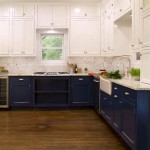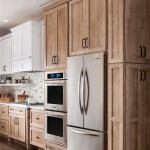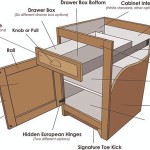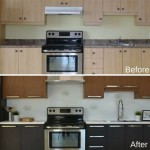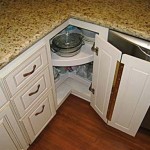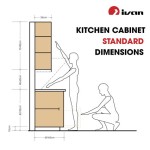How Much Does Kitchen Cabinets Refacing Cost?
Kitchen cabinet refacing is a popular home improvement project that offers a cost-effective alternative to completely replacing existing kitchen cabinets. It involves replacing cabinet doors and drawer fronts, applying a new veneer to the existing cabinet boxes, and often updating hardware like hinges and pulls. The primary appeal lies in its ability to significantly alter the aesthetic of a kitchen without the extensive demolition, disruption, and higher costs associated with a full cabinet replacement.
Determining the cost of kitchen cabinet refacing is not a straightforward process, as several factors influence the final price. These factors can include the size of the kitchen, the materials chosen for refacing, the complexity of the design, and the labor costs in a particular geographic location. This article aims to provide a comprehensive overview of the various elements that contribute to the overall expense of refacing kitchen cabinets, allowing homeowners to make informed decisions and budget effectively for this project.
Key Factors Influencing Refacing Costs
The total cost of kitchen cabinet refacing is determined by a combination of material costs, labor expenses, and the specific characteristics of the kitchen itself. Understanding these individual components is crucial for creating an accurate budget and comparing quotes from different contractors.
Size of the Kitchen: The number of cabinets that need to be refaced is a primary driver of cost. Larger kitchens with more cabinets will naturally require more materials and labor, leading to a higher overall price. The linear feet of cabinets, including both upper and lower cabinets, are often used as a metric for estimating the material needed. A kitchen with a greater number of drawers, specialized cabinets (such as corner cabinets or pull-out shelves), and island cabinets will also increase the project's complexity and cost.
Materials Used for Refacing: The choice of materials for cabinet doors, drawer fronts, and veneers significantly impacts the overall cost. Different materials offer various levels of durability, aesthetic appeal, and price points. Some common material options include:
- Wood Veneer: Real wood veneer is a thin layer of wood applied to the cabinet boxes. It offers a natural wood look and feel but can be more susceptible to scratches and moisture damage compared to other options. Cost varies based on the wood species, with hardwoods generally being more expensive than softwoods.
- Rigid Thermofoil (RTF): RTF is a plastic laminate that is heat-molded onto a core material, typically MDF (Medium Density Fiberboard). It is a durable and cost-effective option that is resistant to scratches and moisture. RTF is available in a wide range of colors and styles, including wood-grain patterns.
- Laminate: Laminate is a synthetic material made of layers of paper and resin, bonded together under high pressure. It is a budget-friendly option that is durable and easy to clean. Laminate is available in various colors and patterns, including those that mimic wood or stone.
- Solid Wood: Solid wood doors and drawer fronts are the most expensive option but offer the highest level of quality and durability. Solid wood can be painted or stained to achieve various looks. Different wood species, such as maple, oak, cherry, or walnut, will also affect the cost.
Complexity of the Design: The complexity of the kitchen design and the desired level of customization will influence the labor costs associated with refacing. Intricate cabinet door styles, such as raised panel doors or doors with applied moldings, require more skilled labor and can increase the price. Modifications to existing cabinets, such as adding new shelves, changing cabinet sizes, or relocating cabinets, will also add to the overall cost.
Labor Costs: Labor costs vary depending on the region, the experience of the contractor, and the complexity of the project. Generally, expect to pay a significant percentage of the total cost for labor. The labor costs cover the removal of existing doors and drawer fronts, the preparation of cabinet boxes for refacing, the application of new veneers, the installation of new doors and drawer fronts, and the installation of new hardware. It is essential to obtain multiple quotes from different contractors and compare their labor rates and project timelines.
Estimating Refacing Costs: A Breakdown
While the exact cost will vary based on the factors mentioned above, it is possible to provide a general estimate of kitchen cabinet refacing costs. These estimates are based on averages and should be used as a starting point for budgeting. Actual costs may be higher or lower depending on the specifics of the project.
Cost per Linear Foot: A common method for estimating refacing costs is to calculate the cost per linear foot of cabinets. The average cost per linear foot for refacing typically ranges from $150 to $500 or more. This price includes the cost of materials (doors, drawer fronts, veneers) and labor.
- Budget-Friendly Options (Laminate or RTF): $150 - $300 per linear foot. This option is suitable for those seeking an affordable way to update their kitchen cabinets.
- Mid-Range Options (Wood Veneer): $300 - $400 per linear foot. Provides a balance between cost and aesthetics, offering a natural wood look.
- High-End Options (Solid Wood): $400 - $500+ per linear foot. Ideal for those seeking premium quality and a luxurious appearance.
Full Kitchen Refacing: A more comprehensive approach is to estimate the total cost for refacing an entire kitchen. The cost can vary significantly depending on the size and complexity of the kitchen.
- Small Kitchen (10-15 linear feet): $1,500 - $7,500.
- Medium Kitchen (15-25 linear feet): $2,250 - $12,500.
- Large Kitchen (25+ linear feet): $3,750 - $17,500 or more.
These estimates include the cost of removing existing doors and drawer fronts, preparing the cabinet boxes, applying new veneers, installing new doors and drawer fronts, and installing new hardware. The estimates also include labor costs, which typically account for a significant portion of the total cost.
Additional Considerations and Potential Costs
In addition to the core refacing costs, several other factors can impact the final price of the project. These considerations should be factored into the budget to avoid unexpected expenses.
Hardware: Replacing existing cabinet hardware (hinges, pulls, knobs) is an integral part of the refacing process. The cost of hardware can range from a few dollars per piece for basic options to $20 or more per piece for high-end designs. The total cost of hardware can be significant, especially for kitchens with many cabinets and drawers. It is important to factor in the cost of hardware when budgeting for refacing.
Modifications and Upgrades: Refacing can be an excellent opportunity to make modifications or upgrades to the existing cabinets. Additional shelves, pull-out organizers, soft-close hinges, and other features can enhance the functionality and convenience of the kitchen. These modifications will add to the overall cost of the project, but they can be worthwhile investments in the long term.
Hidden Costs: Unexpected issues can arise during the refacing process, leading to additional costs. For example, if the cabinet boxes are damaged or warped, they may need to be repaired or replaced, adding to the material and labor costs. It is essential to have a contingency fund to cover potential surprises. Discussing these possibilities with the contractor beforehand is crucial to manage expectations and avoid unexpected bills.
DIY vs. Professional Installation: While it is possible to reface kitchen cabinets as a DIY project, particularly for simpler designs, professional installation is generally recommended. Professional installers have the experience, tools, and expertise to ensure a high-quality finish. DIY refacing can save on labor costs, but it may require a significant time investment and the potential for errors that could lead to additional expenses to correct. Weighing the pros and cons of both options is a crucial step.
Regional Differences: Labor rates and material costs can vary significantly depending on the geographic location. In areas with a high cost of living, labor rates will typically be higher. Material costs may also be higher in areas with limited availability or higher transportation costs. It is essential to obtain local quotes to get an accurate estimate of refacing costs in a specific area.
Contractor Selection: Selecting a reputable and experienced contractor is crucial for a successful refacing project. Obtain multiple quotes from different contractors, check their references and reviews, and ensure they are licensed and insured. A qualified contractor can provide valuable guidance on material selection, design options, and potential challenges. While the lowest bid may be tempting, prioritize quality and reliability over price.
Budgeting for kitchen cabinet refacing requires careful consideration of various factors, including the size of the kitchen, the materials used, the complexity of the design, and the labor costs. By understanding these components and obtaining multiple quotes from reputable contractors, homeowners can create a realistic budget and achieve a successful and cost-effective kitchen renovation.

Average Cost To Reface Cabinets By Li Foot Material And Type Forbes Home

Cabinet Refacing Process And Cost Compared To Painting

What Is The Average Cost For Cabinet Refacing

Average Cost Of Kitchen Cabinet Refacing Mcmanus And Bath Design Build Remodeling Contractors Tassee

Cabinet Refacing Cost Angi

How Much Does Cabinet Refacing Cost 2024 S Homeguide

Cabinet Refacing Cost How Much Will Your Project Be

Kitchen Cabinet Refacing Review Why We Chose It For Our Home Kaitlin Madden

How Much Does Cabinet Refacing Cost N Hance

How Does Kitchen Cabinet Refacing Work
Related Posts

